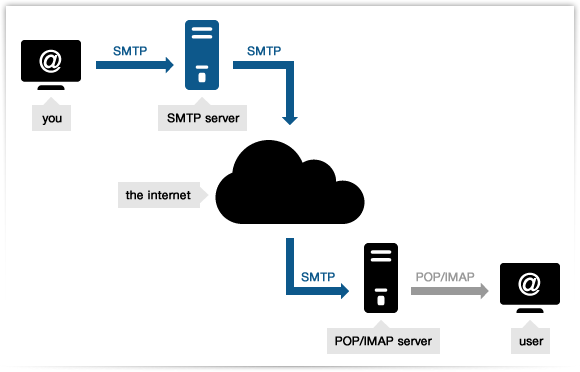
FTP
FTP stands for "File Transfer Protocol" which is responsible for letting you transfer information and files online, it's similar to HTTP (Hypertext Transfer Protocol). However, FTP works on different transmission control protocol ports, which is 20 and 21, those two ports must be open in order for a successful transfers. (Mitchell, November 17, 2017)
TELNET
TELNET allows administrators or users to access other computers remotely.
SSH (Secure Shell)
SSH stands for "Secure Shell", SSH enables file transfers over unsecured networks and it enables secure system administration. SSH is used in large enterprises and in data centres. In addition, it uses port 22 and it uses an encryption to establish a secure connection between a server and a client. Everything gets encrypted files transfers, commands, and output and user authentication to protect the network from attackers.(Secure Shell, 2018)
SMTP
SMTP stands for "Simple Mail Transfer Protocol", SMTP uses port 25. However, SMTP is used in mail servers to both receive and send mail messages.

DNS
DNS stands for "Domain Name System", without a DNS the browser you are using wouldn't know which websites you are trying to go to, because even though you typed the link of the website, your browser needs to know the IP address to be able to take you to the website, so to be able to get to the website your computer sends a request to your domain name system, which then matches the website you are trying to visit with the IP address. (DNS as Fast As Possible, 20, 2016)
HTTP
HTTP stands for "Hypertext Transfer Protocol", which is port 80, it is an application layer protocol, which allows web-based applications to exchange data and communicate, it's used to deliver contents like videos, documents, audios and images. However, after you make a request the client will then disconnect from the server and reconnect when the response is ready to deliver the process.
POP3
POP3 stands for "Post Office Protocol 3", which uses port 110 and it's the recent version of a protocol for receiving e-mail. However, POP3 is a server/client protocol, where e-mail is held and received for you by your internet server. Where you will check your email and download it, POP3 is used by Outlook Express and Eudora and its designed in a way that it will delete the mail on the server as soon as you download it. (What Is POP3, 2017)
IMAP
IMAP stands for "Internet Message Access Protocol", it uses port 143, IMAP gives you more capabilities than POP3 it allows you to organize folders on the server and to save e-mails in the folders and allows the user to manipulate the messages. (What Is IMAP?, 2016)
HTTPS
HTTPS stands for "Hypertext Transfer Protocol Secure" it uses port 443, HTTPs is the same as HTTP but it's more secure.
RDP
RDP stands for "Remote Desktop Protocol" uses port 3389 and RDP is developed by Microsoft, RDP provides you a graphical interface, which will let you connect to another computer over a network connection. ("Remote Desktop Protocol", 2017)
SLP
SLP stands for "Service Location Protocol" uses port 427 and it allows PC's and other devices to find services in a local area network without any prior configuration. (Service Location Protocol, 2017)
AFP
AFP stands for "Apple Filling Protocol", uses port 548 and it is used for sharing personal files and Apple file services.
SNMP
SNMP stands for "Simple Network Management protocol", it organizes and collects information about different devices on IP networks. However, many devices support SNMP like switches, printers, workstations, routers and modems. In addition, SNMP is used for network management for network monitoring. (Simple Network Management Protocol, 2017)
DHCP
DHCP stands for "Dynamic Host Configuration Protocol", it has a goal of assigning new IP addresses to your host. However, DHCP also provides other network addresses such as "The default gateway, Subnet mask and the DNS address". DHCP comes as a server and a client. (DHCP Explained, 2017)
TFTP
TFTP stands for "Trivial File Transfer Protocol" it uses port number 69, it allows the user to put or get a file onto a remote host. ( TFTP, 2017)
SFTP
SFTP stands for "SSH File Transfer Protocol", SFTP is a network protocol that provides file management, file transfer and file access. In addition, SFTP has port number 21.
NTP
NTP stands for "Network Time Protocol", it is a protocol for clock synchronization between computer systems. In addition, it has port number 123.
TLS
TLS stands for "Transport Layer Security". TLS has many ports 25,2525, 587 and 564.
SIP
SIP stands for "Session Initiation Protocol" this protocol is used for controlling and signalling multimedia communication sessions in applications of internet telephony for video and voice calls.
RTP
RTP stands for "Real-time Transport Protocol" it's a protocol for delivering video and audio over IP networks. RTP uses two ports 16384 and 32767.